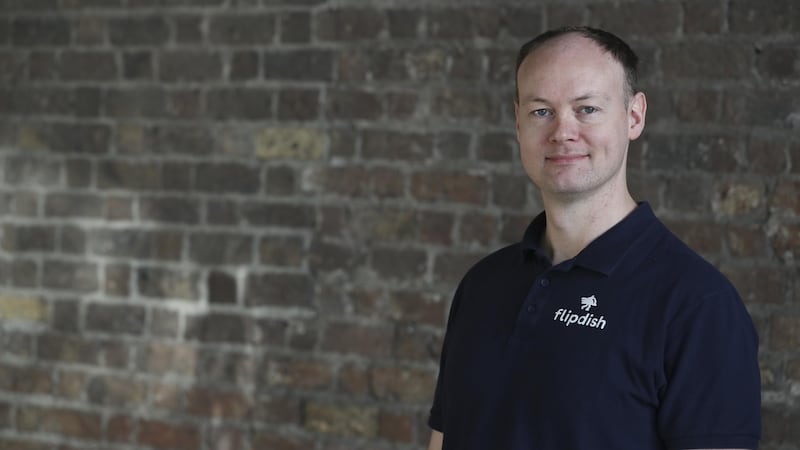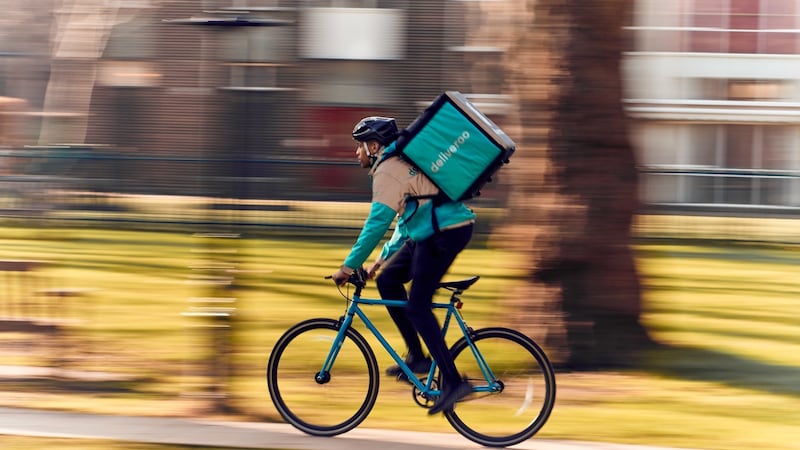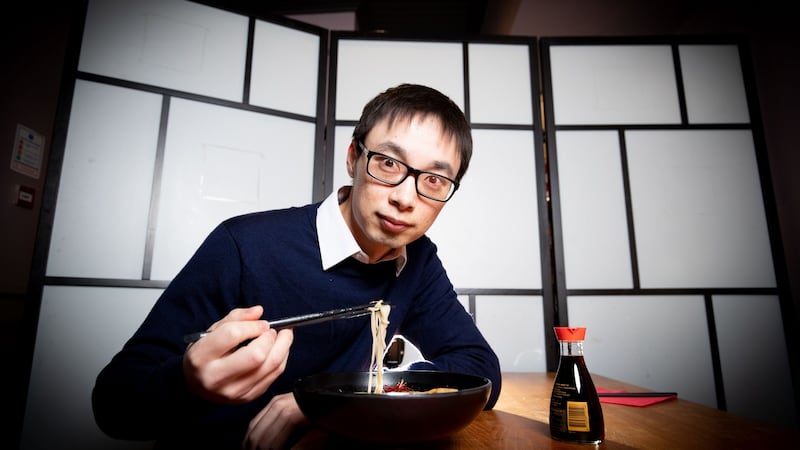Feeling wistful yet for the days of “move fast and break things”? The battle cry of the disrupter pups feels quaint now, those brave-new-worlders disrupting old-world ways so we could order pad thai in pyjamas while streaming The Durrells. Few of them (hello Bill Gates and your prophetic Ted talk) envisaged something that could move as fast and break as many things as Covid-19.
I started looking into food delivery two months ago, prompted by an Irish tech company’s concerns about the designs of hungry marketplace giants on the Irish restaurant scene. I’d rather boil an egg than order Deliveroo, so my experience of delivery was limited to exchanging cyclists’ war-weary glances with couriers battling Dublin’s traffic and wondering occasionally how the occupants of pricey student housing could afford so many couriered dinners.
But food delivery was a growing trend. Drones were due to be tested. The disrupters were circling for casualties of a dine-in restaurant boom creaking at the seams, with rising costs, narrowing margins and the relentless quest for novelty from a single-use restaurant brigade.
We are used to eating out...now we stare into the cold light of our fridges three times a day and consider bribing children to dress up to offer 'still or sparkling'
Food delivery was then estimated to be worth €1.7 billion in Ireland a year. The disruption was both an opportunity and a threat. The biggest danger to small businesses was Amazon-scale tech giants setting up dark kitchens on the M50 to pump out restaurant-like meals from virtual menus.
Dark kitchens, or ghost kitchens, have been hovering on Irish restaurant horizons for a while. Located in industrial estates, in shipping containers or unused shops in cities such as London, these are large-scale kitchens owned by digital delivery platforms such as Deliveroo and Uber Eats.
The question boiled down to this: if we fell head first into the convenience offered by the food delivery giants, what would we stand to lose?
That question seems quaint now with all our restaurants, from two-star Michelins to two-table country tea rooms, gone dark. How restaurants are going to turn the lights on again with social distancing in place for months, or longer, is a hard question for everyone. As diners, we are used to eating out more than any previous generation. Now we stare into the cold light of our fridges three times a day and consider bribing children to dress up to offer “still or sparkling”. But who needs to be reminded of what’s been lost?
So let’s scroll back to The Before for a back story.
Conor McCarthy entered the food delivery game back in 2014 out of frustration at the numerous steps required to use an early days version of Just Eat. The founder of an online poker site, McCarthy was looking for a wholesome business and decided to make a more seamless delivery app with fewer clicks, to take seconds rather than minutes, setting out, in effect, to build a better mouse trap.

Flipdish was born and McCarthy and his brother James went to talk to the restaurants and takeaways about their nimbler marketplace app. But some potential customers started telling them how unhappy they were with the existing one.
“The restaurants were realising the marketplaces were a threat to them. They told us the rates had gone up each year since Just Eat came to Ireland and they felt they couldn’t turn off the marketplace because they felt they had no other option. They didn’t know how to build the technology themselves or it was too expensive to maintain,” McCarthy explained sitting in his busy office in Sandyford, where many of the 60 Flipdish employees worked.
It was one thing for a cafe to build an ordering system, but staying visible and viable was more difficult, as each new iPhone required software updates. So Flipdish flipped from being a sleeker marketplace aggregator to building restaurants’ own apps and websites.
It was a model that worked, albeit on a smaller scale to the marketplace apps. At the start of March around 200,000 food orders a month were going through Flipdish’s branded apps in Ireland, the UK, Spain, the Netherlands, Germany, France and New York.
In the immediate aftershock of lockdown more than 500 of Flipdish’s 1,600 businesses across its markets closed their doors and stopped producing food. But in the subsequent weeks they’ve seen an increase of slightly more than that in new cafes and restaurants pivoting their dine-in business into delivered food.
“Lots of new stores have come on board,” McCarthy told me, now speaking from his home attic office. “Lots of those are typical dine-in restaurants.”
From being a sideline to your main business, delivery or click and collect has become the business.
“It feels like the trends that were happening anyway have been accelerated,” McCarthy says. “People were moving from offline to online in general and that’s been accelerated. People were ordering click and collect and that’s happening more.”
Deliveroo doesn't publicly disclose its rates, which can range between 14 and 30 per cent
Flipdish has seen credit and debit card orders grow from 63 per cent to 86 per cent in the last three weeks. “We’ve seen the average order value has gone up 40 per cent, so people are ordering more, across the board for us for delivery orders.”
People are ordering food earlier than they used to, perhaps because of the widespread elimination of commutes, or shorter working days. “Our orders are up 20 per cent in the late afternoon and are down in the early evening. I’m not sure exactly why,” McCarthy says.
Flipdish is up against tough and gigantic competition. In the six years since it was established, Just Eat has been joined in the Irish market by Deliveroo and, last year, Uber Eats. The giants are growing. Amazon recently invested half a billion euro in Deliveroo, in a deal that’s being examined by the UK Competition and Markets Authority. Just Eat was recently taken over by Dutch firm Takeaway.com.
A Deliveroo spokesman said the tech company has a total reach of 1.4 million people in Dublin, Cork, Limerick and Galway. What does that mean? “Total reach refers to the number of people who Deliveroo can actually deliver to.”
How many people does it actually deliver to? “The number of deliveries unfortunately is something Deliveroo don’t publicly disclose,” the spokesman said. Deliveroo also doesn’t publicly disclose its rates, which can range between 14 and 30 per cent, according to McCarthy.

Flipdish charges businesses €399 to set up their own branded app and 7 per cent on the deliveries through the app.
There are parallels between the arrival of delivery apps and the arrival of supermarkets in the 1970s and 1980s. At first the opportunities of gleaming shelves seemed dazzlingly optimistic. Small names could grow large on the shoulders of benign giants. That happened for many, but a tiny number of vast and ruthless players replaced a network of thousands of connected businesses selling to their locality. Centralised warehouses serviced by a globalised food industry left smaller and smaller numbers of powerful corporations controlling the bulk of household spending. In the name of convenience the power went one way.
McCarthy cautions restaurants about running into the embrace of the giants. He would say that; they are his competition. “But you have these restaurants who have sent all their customers to a marketplace, who are not in control of the customer ordering experience,” he argues. “They’re not in control of the delivery and soon they’re going to be competing against the marketplace for space.”
This is the spectre of backward integration, where delivery services swallow the restaurants they once provided with a platform. It is a business model some analysts argue was perfected by Amazon, to mind-bogglingly profitable effect. The online store first facilitates a small business to sell to millions, then offers their products at lower price, swallowing them whole.
If information is power,the marketplace has all the power. “It’ll make a lot of sense for Deliveroo to look at all their customer data, see what’s popular in certain areas and make lookalike brands and direct people to those,” McCarthy said back in early March.
I don't think we'll replace human beings. People like tasty food, and only people understand what makes food tasty
When I asked Deliveroo’s PR company about this they put me in touch with Jay Chen, one of their (then) 1,200 “restaurant partners”. Chen opened Musashi on Dublin’s Capel Street in 2012 after coming to Ireland four years earlier to work as a chef in a Chinese restaurant in Parnell Street and doing a year in Yo-Sushi. Eight years later he had built a chain of six Musashi restaurants in Dublin.
He started using Deliveroo in 2016 because, he said, he liked the ability to see where the courier was, given the traffic congestion in Capel Street. Deliveries typically accounted for under two per cent of his Capel Street trade but up to half of the Musashi business on Hogan Place, where there was lighter footfall after lunchtime. Most online orders were for two portions, but many are just for one. He felt he had little choice but to put Musashi on one of the big platforms because that was where people were going to order food. “If you’re not part of it, people know you less and less.”
We met at one of his tables in Capel Street on a busy lunchtime, the first Monday in March, a lifetime ago. The long narrow room was filled, every table packed with suited lawyers and business people. Chen explained he had a new restaurant, a bento box operation called Yamato, once a Japanese province and also a word for “big and peaceful”. In truth, Yamato was small and virtual, existing only as stove space in the kitchen at Musashi.
Instead of an Irish dark kitchen, Deliveroo was, for the moment, encouraging businesses to create virtual brands that use the capacity of their own kitchens. Chen had done just that.

I had some questions back then. Did Chen fear that Deliveroo would one day start its own bento and sushi operation and eat all his customers? “It’s not that easy for them,” he said. “It’s very hard to find good staff and if a person coming to work doesn’t have passion I believe you can taste that in the food.”
Will this delivery culture take us down the road to dark kitchens staffed by robots? “I don’t think we’ll replace human beings. People like tasty food,” he said, and only people understand what makes food tasty.
Will convenience culture be the death of us? “It depends how we use it,” he said.
Today Chen’s chain is down to one operation in Hogan Place, where all the food for delivery is made. Chefs wear masks and glasses, sanitise and socially distance in the kitchen. It is keeping things ticking over but Chen says with all his food business now boiled down to Deliveroo only, the stark reality of the partnership is real.
“The commission is huge,” he says. But it is his only route to market. People are used to ordering food from the brand they know. It is not a time when he can try to get his own brand onto their radar.
Since lockdown restrictions Deliveroo Ireland “on-boarded 100 new restaurants in just two weeks,” the spokesman said, bringing its total number to 1,300. They have dropped on-boarding fees, introduced contact-free delivery and shared advice on how to operate safely.
“We are here to deliver for restaurants who want to carry on offering their amazing food to families at home during this difficult time,” Deliveroo Ireland general manager Michael Healy said in an email. “We are working with restaurants to optimise their operations for delivery, and we are doing everything we can to make sure people still have access to the food they want and need.”
And how long will any lighter introductory charges be maintained? “Deliveroo will maintain reduced fees for as long as necessary,” the spokesman said.
Back in March, owner of Thai food chain Camile, Brody Sweeney compared the then-new landscape of online marketplaces to the music industry. Because talent can launch with far less money up front, “it’s really easy to get into the food business now”. Accessing space in a cloud kitchen, you can be in business for under €10,000. (This is a kitchen where restaurant food is made but nobody sits down to eat.)
“If the food is really great and you’re a little bit smart on branding it, in theory the opportunity is there to get your food out on a platform.”
Sweeney was working with three dark kitchens in London and had opened his first virtual brand on Deliveroo called Slammin Ramen in Dublin and London. Ramen delivered has not been an easy proposition. Add the noodles to the broth too soon and they soak it up like a sponge. Then there’s the slew of food packaging waste, single-use containers binned as soon as they’re emptied. (Camile uses compostible ones but Sweeney knows that’s still a lot of wasted materials.)
He realised quickly after lockdown that their weekday customers for Camile were time-poor people with empty fridges. Both those were no longer a given. After schools closed, in our rush to stock fridges and an outbreak of home cooking, that weekday business dropped off a cliff.
But there’s been a balancing increase in orders at weekends, so after a dramatic lurch, they’ve levelled off at about the same rate they were before the crisis both in London and Dublin, Sweeney says. He’s also noticed an older demographic ordering with them for the first time. Sweeney thinks restaurants will come back, but the unknown length of time that will take is the difficulty.
'Takeaway-only won't pay the backlog of rent, VAT, rates accumulating while we're closed'
“My heart really goes out to the ones who’ve closed. We’ll be putting something together to license the Camile brand out to restaurants who are closed around the country.”
Camile could grow its own network of dark or cloud kitchens. It is, grimly or optimistically (depending on your outlook) a potential gang plank along which restaurants can reach their diners again while social distancing remains in place. “Anybody who’s got a restaurant with a kitchen could be a cloud kitchen,” Sweeney says.
Not everyone sees that as a simple proposition. Vanessa Murphy of Spanish restaurant Las Tapas de Lola is putting one foot in front of the other. She equates it to “the days when I had cancer. You take everything just one day at a time.”
She and her partner, Anna Cadrera, had spoken to Deliveroo days before deciding to close their restaurant on Friday, March 13th. They have not been able to open as a delivery operation because “the problem is Anna and myself aren’t chefs”, unlike nearby Richmond Restaurant, seen by many as the model way to pivot from in-house dining to delivery and collection. But the secret there is that Richmond is a “one-man kitchen”, Murphy explains.
Relying on several staff to cook their food at Las Tapas de Lola means they can’t guarantee social distancing in the kitchen. “It’s not even just doing the social distancing in the kitchen, it’s asking our staff to travel, what you expose them to.” She is uncertain how soon the dine-in restaurant will bounce back. “People will be a lot more wary.”
They are grateful for an understanding landlord and the support of the food community around them. They visit the restaurant every second day “to run the taps and check the fridge temperatures”. At the time of writing they have plans to go in to celebrate Vanessa’s birthday, sitting on chairs opposite each other with a glass of vermouth. In the meantime they’re keeping their customers close with recipes and social media posting and keeping sane with trips to the park with their beloved dogs.
“Technology and owning a dog” is feeling like salvation. “Takeaway-only won’t pay the backlog of rent, VAT, rates accumulating while we’re closed, but it will be a step towards some form of a new normality,” Murphy says.
Food writer Joe McNamee and his friend Donal Moran of software company WASP Technologies put together EatforIreland.ie to connect diners with an “eat out at home” option and with producers selling ingredients to cook at home.
“The response of the Irish food world has, as always, been immediate, innovative and brave, and the Irish public have responded in kind, expressing a huge desire to support this very valued sector, but connecting the two has been problematic,” McNamee said. He hopes EatforIreland.ie will begin the work of making a fairer food system for everyone.
In Terenure, Kevin Byrne of Mayfield restaurant has a one-man kitchen operation, with his business partner (also called Kevin) as chef. Byrne and his husband Danni run a deli counter selling soup, cakes, a takeaway dinner, grab-and-go food such as smoked hake, salmon fishcakes or lasagne. It’s helping them keep the lights on and many of his customers welcome the break of buying a ready-made lunch before facing into the daily dinner challenge.
At the end of lockdown, if people are feeling like he is, “nobody will want to see their home kitchen ever again,” he jokes.
He received a phenomenal delivery a few days after they closed: a handwritten letter. “Dear Kevin and Kevin, I have enjoyed many meals in the Mayfield and hope to do so again in the future,” it reads. “This is a very difficult time for you all and I would like to give you this gift to pay some of the bills. Keep well. From a very grateful customer.” She signed her name and enclosed a cheque for €1,000.
This kind of connection and community will be needed to keep Ireland’s post-crisis restaurant scene from becoming a landscape of dark kitchens, mass delivery systems and a dine-in era of small chef-owned restaurants on many corners remembered only as a lost age.















